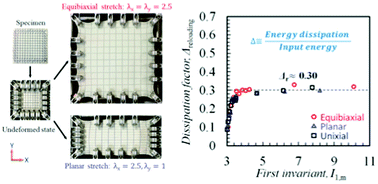Novel features of the Mullins effect in filled elastomers revealed by stretching measurements in various geometries†
Abstract
Stretching experiments with various geometries are performed using a custom-built tensile tester to reveal the intriguing features of the mechanical softening phenomena of filled elastomers in loading–unloading cycles, commonly known as the Mullins effect. The dissipated energy (D), residual strain (εr), and dissipation factor (Δ; the ratio of D to input strain energy) in the loading–unloading cycles are evaluated as a function of the maximum stretch in cyclic loading (λm) using three types of extension, i.e., uniaxial, planar, and equibiaxial extension, for silica-filled elastomers with various filler contents, and with or without a silane coupling agent. The dissipated energy D and εr increase with an increase in λm, and they depend on the type of extension when compared at the same λm: D and εr increase in the order of equibiaxial, planar, and uniaxial extension. In contrast, the values of Δ obtained for various degrees and types of extension are collapsed into a single curve when the first invariant of the deformation tensor (I1,m) corresponding to λm is employed as a variable: Δ steeply increases with an increase in I1,m in the small deformation regime of I1,m < 3.2, while Δ levels off in the large deformation regime of I1,m > 3.5. The plateau values of Δ increase with an increase in filler content. The characteristic dependence of Δ on I1,m in each of the small and large deformation regimes is expected to reflect the destruction process of the inherent structures, including filler networks and the filler–polymer interface, and the friction between the fillers and the rubber matrix, respectively.



 Please wait while we load your content...
Please wait while we load your content...